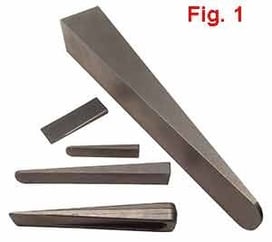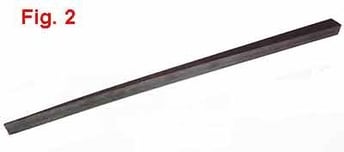Steel Wedges are used in fabrication and steel erection for a wide variety of purposes. Some are very simple and rudimentary, others more specific and complex. When a job requires structural steel wedges, the fabricator or erector will have a choice between mass produced stock sizes and made to order sizes. The key phrase in that sentence is “mass produced.”
In steel wedge manufacturing, mass production is a very significant advantage in terms of consistency and quality of the finished product in relation to cost. Once a set of specifications is determined and it is certain that size will be used repeatedly, hard tooling can be made that will reproduce an almost unlimited quantity of that item. While tooling does wear with repeated use, properly designed steel wedge tools can be maintained so the finished product shows no visible difference over hundreds of thousands of copies. As an example of hard tooling use, The Steel Supply Company uses many different tools to produce our Slotted Steel Shim. Some of the more popular sizes have been run over one million times and with proper hardness and periodic maintenance still continue to produce accurate, high quality steel shims.
To view the Slotted Steel Shims click here.
 The assortment shown (Fig. 1) are all steel wedges manufactured using hard tooling. Each is accurate to the intended dimensions, but more importantly, all edges are straight and they are within range of a consistent hardness. While unseen, hardness is probably the most important attribute in steel wedge manufacturing. Too soft and the wedge will easily peen at the driven end and score at the point where it meets the workpiece. Too hard and it can crack or shatter, or worse, still dangerous small chips will fly off when the wedge is struck. This is why it is important to wear eye protection whenever driving a steel wedge.
The assortment shown (Fig. 1) are all steel wedges manufactured using hard tooling. Each is accurate to the intended dimensions, but more importantly, all edges are straight and they are within range of a consistent hardness. While unseen, hardness is probably the most important attribute in steel wedge manufacturing. Too soft and the wedge will easily peen at the driven end and score at the point where it meets the workpiece. Too hard and it can crack or shatter, or worse, still dangerous small chips will fly off when the wedge is struck. This is why it is important to wear eye protection whenever driving a steel wedge.
For more information on Steel Wedge hardness click here.
When Made to Order Wedges are required, deflection and hardness become variables. The process starts with steel already rolled into its desired form, typically bar stock or plate. Cutting away sections, the size of the wedge desired, or cutting away rectangular blocks and then cutting again diagonally will produce, in rough form, the same effect. From here, finish machining can produce more specific dimensions and the necessary surface finish.
One problem that occurs is that within any finished piece of steel stress (pressure) is being exerted equally in every direction or at least equal enough that the steel holds its shape. When an uneven section is cut away, that stress now missing the offsetting resistance, will cause deflection. Additionally, depending on the method of cutting and the amount of heat involved the deflection can increase.
 Fig. 2 shows a Made to Order Steel Wedge 14” long x 1/2” wide. Height is 1/2” at the thick end and 1/16” at the thin end. While it appears straight, closer examination shows the deflection that begins halfway along the length and continues toward the thin end.
Fig. 2 shows a Made to Order Steel Wedge 14” long x 1/2” wide. Height is 1/2” at the thick end and 1/16” at the thin end. While it appears straight, closer examination shows the deflection that begins halfway along the length and continues toward the thin end.
As mentioned above, the two factors influencing deflection are relief of stress and reaction to heat. This steel wedge is a good example of the effect heat will have. The thin dimensions diminish the effect of the stress relief, but increase the effect of heat deflection.
 In Fig. 3, the steel rule is perfectly straight. At the maximum gap, the wedge separates by 3/16”. As well, though it cannot be seen in Fig. 3, over the last 1” of the thin end the wedge actually deflects back upward, away from the ruler.
In Fig. 3, the steel rule is perfectly straight. At the maximum gap, the wedge separates by 3/16”. As well, though it cannot be seen in Fig. 3, over the last 1” of the thin end the wedge actually deflects back upward, away from the ruler.
In many cases, the type of deflection shown above is incidental to the requirements and performance of the steel wedge. However, when considering Made to Order Steel Wedges it is helpful to consider these variables. If greater precision and tighter tolerances are called for, machining is required resulting in increased man hours, material waste and cost.





